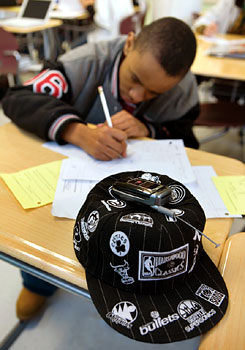How to Use Social-Networking Technology for Learning
Why teachers should embrace networking, and how they can use it to improve education.
This how-to article is accompanied by the feature "Social Networking at Science Leadership Academy."
Social-networking tools aren't just for flirting. The evolving world of Internet communication -- blogs, podcasts, tags, file swapping -- offers students radically new ways to research, create, and learn. But, too often, schools use computers as little more than glorified workbooks, and that's criminal, says Chris Lehmann, principal of Philadelphia's Science Leadership Academy. He explains why teachers should embrace networking and how they can use it to improve education.
What exactly is social networking?
It's software that allows people to come together around an idea or topic of interest. A school could use blog software to bring together anyone who's writing about politics or computing or Greek literature.

Why should schools encourage all this sharing and meeting?
Schools should reflect the world we live in today. And we live in a social world. We need to teach students how to be effective collaborators in that world, how to interact with people around them, how to be engaged, informed twenty-first-century citizens. We need to teach kids the powerful ways networking can change the way they look at education, not just their social lives. We don't talk enough about the incredible power of social-networking technology to be used for academic benefit. Let's change the terms. Let's not call it social networking. Let's call it academic networking.
What's a good way to get started?
A teacher can set up kids with accounts at the Web site Delicious, which lets you store, organize, and share links -- for example, an annotated resource list you use on a project. You can also see links other people have saved, or browse to see what everyone has bookmarked on a subject. It's simple. You don't need your own server. Any teacher with a computer and an Internet connection can use it.
How do you keep students from wasting time chatting or sneaking to inappropriate sites?
You teach! You have frank discussions. You show them examples and ask them to make ethical decisions. You ask: What does it mean that fifteen-year-old kids are calling themselves nineteen and posting racy pictures online? What does it mean that college kids are posting raunchy spring break pictures that a prospective employer can find? The idea that we are the stories we tell has never been more important. Schools have always taught kids how to present themselves -- that's why we did oral presentations in the classroom. Now we need to teach them to present themselves electronically. That's why it's so scary to lock these technologies out.
The school day is already jam packed. How do you find time for networking?
Administrators have to facilitate change. A lone teacher can do it, but it's hard to sustain. Administrators have to decide this is valued for the whole school community, and they have to give teachers time and freedom to learn, experiment, and play. Lots of teachers are doing it on their own, but it can be exhausting. That's classroom 2.0, not school 2.0.